Scutula is a genus of lichenicolous fungi in the family Ramalinaceae.
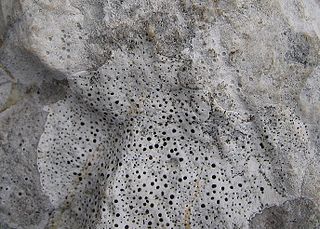
Verrucariales is an order of ascomycetous fungi within the subclass Chaetothyriomycetidae of the class Eurotiomycetes. Although most of the Verrucariales are lichenised, the family Sarcopyreniaceae consists of 11 species of lichenicolous (lichen-dwelling) fungi.
The Adelococcaceae are a family of fungi in the order Verrucariales. Species are mostly found in north temperate regions, and are biotrophic or necrotrophic on lichens. The family was proposed by mycologist Dagmar Triebel in 1993.
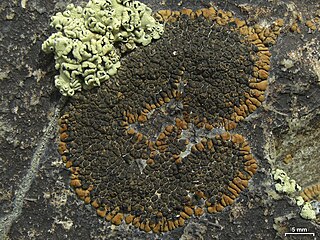
Sphaerellothecium is a genus of fungi in the family Phyllachoraceae. All of the species in the genus are lichenicolous, meaning they grow parasitically on lichens.
Endococcus is a genus of lichenicolous (lichen-dwelling) in the family Lichenotheliaceae. It has 44 species. The genus was circumscribed by the Finnish botanist William Nylander in 1855. Although at least one source places the genus in the Verrucariaceae, a 2016 study of the type species, Endococcus rugulosus, determined that it should instead be placed in the family Lichenotheliaceae of the order Dothideales; this classification echoes a placement proposed in 1979 by David Hawksworth.
Sarcopyrenia is a genus of lichenicolous (lichen-dwelling) fungi. It has 11 species. It is the only genus in Sarcopyreniaceae, a family in the order Verrucariales. Sarcopyrenia was circumscribed by Finnish lichenologist William Nylander in 1858, with Sarcopyrenia gibba assigned as the type species. Sarcopyreniaceae is one of the few families composed entirely of lichenicolous fungi.

Abrothallus is a genus of lichenicolous (lichen-dwelling) fungi. It is the only genus in the monotypic family Abrothallaceae, which itself is the sole taxon in the order Abrothallales.

David Leslie Hawksworth is a British mycologist and lichenologist currently with a professorship in the Universidad Complutense de Madrid in Madrid, Spain and also a Scientific Associate of The Natural History Museum in London. Hawksworth has had a prolific career, authoring nearly 600 scientific works, describing approximately 250 new taxa, and proposing around 500 new combinations or new names in fungal nomenclature. In 1996, he was honoured as Commander of the British Empire (CBE). In 2002, he received the Acharius Medal from the International Association for Lichenology. Five genera and many species have been named in his honour.
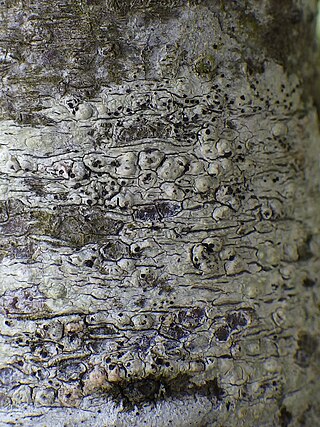
Skyttea is a genus of lichenicolous (lichen-dwelling) fungi in the family Cordieritidaceae. The genus was circumscribed in 1981 by lichenologists Martha Allen Sherwood, David L. Hawksworth, and Brian J. Coppins, with Skyttea nitschkei assigned as the type species.

Phacopsis is a genus of lichenicolous (lichen-dwelling) fungi. They are parasites of members of the large lichen family Parmeliaceae, of which they are also a member. Originally proposed by Edmond Tulasne in 1852 to contain 3 species, Phacopsis now contains 10 species, although historically, 33 taxa have been described in the genus. Many of the species are poorly known, some of them having been documented only from the type specimen.

A lichenicolous fungus is a member of a specialised group of fungi that live exclusively on lichens as their host organisms. These fungi, comprising over 2,000 known species across 280 genera, exhibit a wide range of ecological strategies, including parasitism, commensalism, and mutualism. They can be found in diverse environments worldwide, from tropical to polar regions, and play important roles in lichen ecology and biodiversity. Lichenicolous fungi are classified into several taxonomic groups, with the majority belonging to the Ascomycota and a smaller portion to the Basidiomycota. Their interactions with host lichens range from mild parasitism to severe pathogenicity, sometimes causing significant damage to lichen communities.
Briancoppinsia is a fungal genus in the family Arthoniaceae. It is monotypic, containing the single species Briancoppinsia cytospora, a lichenicolous fungus that parasitises parmelioid lichens, as well as Cladonia, Lepra, and Lecanora conizaeoides, among others. The species was first described scientifically by Léon Vouaux in 1914 as Phyllosticta cytospora.
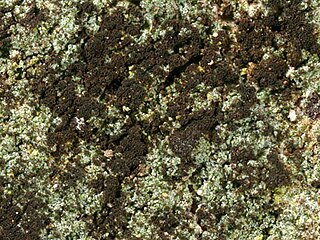
Reichlingia is a genus of lichen-forming fungi in the family Arthoniaceae. It has seven species. The genus was originally circumscribed by Paul Diederich and Christoph Scheidegger in 1996, with Reichlingia leopoldii as the type, and at that time, only species. The fungus was at first thought to be a lichenicolous (lichen-dwelling) fungus, but is now considered a lichenised hyphomycete.
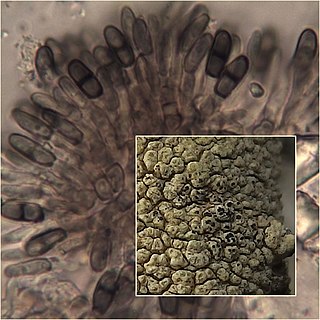
Minutoexcipula is a genus of lichenicolous (lichen-dwelling) fungi of uncertain familial placement in the order Chaetothyriales. It has eight species. The genus was circumscribed in 1994 by M. Violeta Atienza Tamarit and David Leslie Hawksworth, with Minutoexcipula tuckerae assigned as the type species. The genus is characterized both by its black convex sporodochia-like conidiomata, as well as the well-differentiated exciple on these structures.
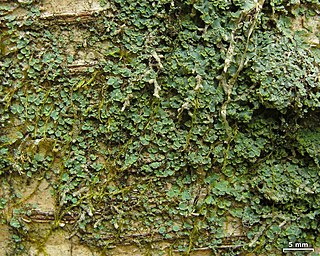
Normandina pulchella, commonly known as the elf-ear lichen or blue heart, is a species of squamulose lichen in the family Verrucariaceae. This cosmopolitan species is widely distributed across both hemispheres, where it thrives in moist microhabitats. It favours moss-covered deciduous trees and rocks, often colonising over mosses and bryophytes. It occasionally grows on bare bark and on other lichens. Distinctive features of N. pulchella include its bluish-green squamules (scales) with sharply raised margins, non-reactivity to standard chemical spot tests, and growth in humid habitats. Initially, Nannochloris normandinae, a green alga, was thought to be its photobiont. More recent studies, however, have revised this understanding, with Diplosphaera chodatii now recognised as the algal partner.

Tremella parmeliarum is a species of lichenicolous (lichen-dwelling) fungus in the family Tremellaceae. Its host is the foliose lichen species Parmotrema reticulatum.
Corticifraga peltigerae is a species of lichenicolous (lichen-dwelling) fungus in the family Gomphillaceae, and the type species of the genus Corticifraga. Its typical host lichen is Peltigera, although on occasion it is found on Solorina and Pseudocyphellaria. The fungus was first described in 1867 by the German botanist Karl Wilhelm Gottlieb Leopold Fuckel, who initially classified it in the genus Peziza. It has been transferred to several genera early in its taxonomic history, before ending up in Corticifraga, which was newly circumscribed by David Leslie Hawksworth and Rolf Santesson in 1990 to contain lichenicolous fungi previously referred to Phragmonaevia.
Globosphaeria is a fungal genus that grows on lichens, containing the single species Globosphaeria jamesii. The fungus is characterised by dark, spherical fruiting bodies producing colourless, round spores, and is found growing on the lichen Normandina pulchella. First collected in Tasmania in 1907 but not described until 1990, it was later also discovered in the United States, making it known from just two locations globally. Though initially placed in the Xylariales, the genus is now classified in the order Sordariales, though its exact family placement remains uncertain.
Tremella normandinae is a species of lichenicolous (lichen-dwelling) fungus in the family Tremellaceae. The species was described as new to science based on material collected in Hawaii. The holotype specimen is preserved in the Botanische Staatssammlung München under accession number M 4837. The only known collection comes from the lichen Normandina pulchella growing on dead Acacia koa trees in sunny exposures in Hawaii. Infection by the fungus results in the formation of pale galls on the host lichen.









